
Johannes Zollikofer (born 29 December 1633 in St. Gallen; died 23 April 1692 in Herisau) was a Swiss reformed vicar.

Johannes Zollikofer (born 29 December 1633 in St. Gallen; died 23 April 1692 in Herisau) was a Swiss reformed vicar.
Johannes Zollikofer studied in Zürich and Basel. At the age of twenty he was called as a German vicar to Geneva. He later continued his studies in Oxford and Cambridge. [1] He worked as a deacon in St. Leonhard and St. Gallen, and later as a vicar und chamberlain in Herisau in Appenzell Ausserrhoden. [2] He was author and translator of many books.

According to the Stemmatologia Sangallensis of Johann Jacob Scherrer (1653–1733) he was 1653–1692 vicar, 1653–1654 German Adjunkt in Geneva, 1655–1655 German assistant in Amsterdam, 1657–1692 Synodalis, 1657–1666 deacon in St. Leonhard, 1657–1692 Collega Disputat., 1657–1692 Collega music., 1660–1660 Bußner Coll. theol. I, 1665–1665 Bußner Coll. theol. II, 1666–1692 vicar in Herisau, (the 13th since the reformation), [3] 1667–1692 Synodalis of Ausserrhoden, 1671–1692 Camerarius of Ausserrhoden and 1684–1692 Ordinari civil registry officer in Ausserrhoden. [4]

Zollikofers sermon on The unholy fiends' miserable condition (Der unseligen Unholden elender Zustand), held on 5 May 1689 in Herisau and printed in the same year in St. Gallen, is based on the publication Magiologia - Christian warning regarding superstition and sorcery (Magiologia - Christliche Warnung für dem Aberglauben und der Zauberei) of Bartholomäus Anhorn the Younger, in which magical practices are criticised. Witch-hunts were conducted with reference to his sermon. [5] [6]
His master piece A Newly Opened Treasury of Heavenly Incense, or Christian's Companion: Containing Instructions and Devotional Exercises, Applicable to All Persons and Circumstances in Life (Himmlischer Weyhrauch-Schatz) was published in 1691 and reprinted in high numbers over 150 years. [7] [8]
The inscription H. Johannes Zollikofer, Pfarrer in a bell of the church in Herisau, which was cast in 1679, reminds on this vicar. [9]
Johannes Zollikofer was a son of Georg Zollikofer (1591–1634) and Judith Schobinger. He married on 3 November 1657 Catharina Gonzenbach (1631–1672), a daughter of Heinrich Gonzenbach and Sabina Zwicker. He had with her one baby daughter in 1663, who died without being christened, and 1665 a daughter Judith.
In his second marriage he married on 11 June 1672 Susanna Zollikofer (1644–1685 in Herisau), a daughter of Niklaus Zollikofer and Benigna Zollikofer and had with her four children: Magdalena (1673–1700 in Amsterdam), Georg Niklaus (1676–1706 in Eastern India), Johannes (born 1681), who died as a baby, and another Johannes (born 1683).
In his third marriage he married on 15 June 1686 Elisabeth Zollikofer (1656–1694), daughter of David Zollikofer and Elisabeth Högger and had with her three children: David (born 1688), Elisabeth (1690–1694) and Gottlieb (1691). [4]

The 26 cantons of Switzerland are the member states of the Swiss Confederation. The nucleus of the Swiss Confederacy in the form of the first three confederate allies used to be referred to as the Waldstätte. Two important periods in the development of the Old Swiss Confederacy are summarized by the terms Acht Orte and Dreizehn Orte.

The Bodensee–Toggenburg railway is a mainly single-track standard-gauge line connecting Romanshorn on Lake Constance and the Toggenburg region in Eastern Switzerland. It was built by the Bodensee-Toggenburg-Bahn (BT), a former railway company, which existed from 1910 until its merger with the "old" Südostbahn (SOB) to form the "new" Südostbahn (SOB) on 1 January 2001. Today, the line together with the Wattwil–Ebnat-Kappel section forms the eastern network of the Südostbahn.

Appenzell Ausserrhoden, in English sometimes Appenzell Outer Rhodes, is one of the 26 cantons forming the Swiss Confederation. It is composed of twenty municipalities. The seat of the government and parliament is Herisau, and the seat of judicial authorities are in Trogen. It is traditionally considered a "half-canton", the other half being Appenzell Innerrhoden.

Herisau is a municipality and the capital of the canton of Appenzell Ausserrhoden in Switzerland. It is the seat of the canton's government and parliament; the judicial authorities are situated in Trogen.
Stein is a municipality in the canton of Appenzell Ausserrhoden in Switzerland.

Appenzell was a canton in the northeast of Switzerland, and entirely surrounded by the canton of St. Gallen, in existence from 1403 to 1597.
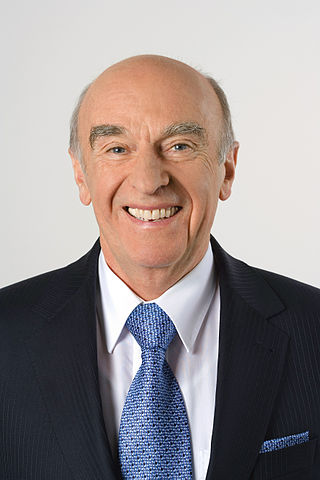
Hans-Rudolf Merz is a Swiss politician who served as a Member of the Swiss Federal Council from 2004 to 2010. A member of the Free Democratic Party (FDP/PRD) until the foundation of FDP.The Liberals in 2009, he headed the Federal Department of Finance during his tenure as a Federal Councillor. Merz served as President of the Swiss Confederation in 2009.
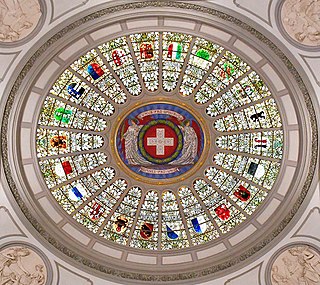
Each of the 26 modern cantons of Switzerland has an official flag and a coat of arms. The history of development of these designs spans the 13th to the 20th centuries.
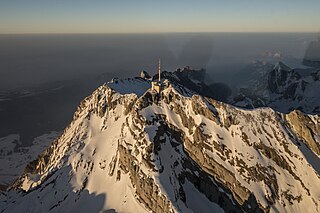
At 2,501.9 metres (8,208 ft) above sea level, Säntis is the highest mountain in the Alpstein massif of northeastern Switzerland. It is also the culminating point of the whole Appenzell Alps, between Lake Walen and Lake Constance. Shared by three cantons, the mountain is a highly visible landmark thanks to its exposed northerly position within the Alpstein massif. As a consequence, houses called Säntisblick can be found in regions as far away as the Black Forest in Germany. Säntis is among the most prominent summits in the Alps and the most prominent summit in Europe with an observation deck on the top. The panorama from the summit is spectacular. Six countries can be seen if the weather allows: Switzerland, Germany, Austria, Liechtenstein, France, and Italy.

The Old Swiss Confederacy or Swiss Confederacy was a loose confederation of independent small states, initially within the Holy Roman Empire. It is the precursor of the modern state of Switzerland.
The Seyler family is a Swiss family, originally a patrician family from Liestal near Basel. Family members served as councillors and Schultheißen of Liestal from the 15th century, later also as members of the Grand Council of Basel. A Hamburg branch descended from the banker and renowned theatre director Abel Seyler became by marriage a part of the Berenberg banking dynasty, co-owners of Berenberg Bank and part of Hamburg's ruling class of Hanseaten.
Appenzell Railways is a Swiss railway company with headquarters in Herisau. It operates a network of railways in the cantons of Appenzell Innerrhoden, Appenzell Ausserrhoden, St. Gallen and Thurgau.
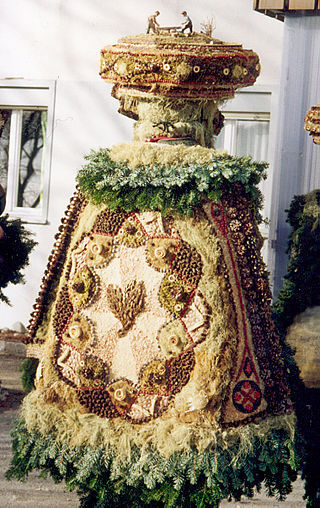
Silvesterklaus is a masked person taking part in Saint Sylvester's Day festivities in Appenzell, Switzerland, and thus contributing to maintain the Chlausen tradition. A Silvesterklaus or New Year's Mummer is dressed up as a Saint Sylvester or New Year's Eve character. In the Reformed half-canton of Appenzell Ausserrhoden, the turn of the year is still celebrated in this way.

Hans Altherr is a Swiss politician. He is a member of FDP.The Liberals and served as President of the Council of States in 2011 and 2012.

Georg Joachim Zollikofer was a Swiss-German theologian who popularized Enlightenment theology, and published several books of sermons and hymns.

Rosenburg Castle is a ruined castle located to the west of the municipality of Herisau in the canton of Appenzell Ausserrhoden in Switzerland. It is a Swiss heritage site of national significance. The castle is on the Ramsenstock and is therefore also called Ramsenburg.

Jakob Andreas Ivo Fürer was a Swiss prelate of the Roman Catholic Church. He was Bishop of St. Gallen from 1995 to 2005.
Helen Meier was a Swiss writer.
Gregor Gustav Adolf Tobler (1834-1875) was a Swiss merchant, artist, and naturalist. He immigrated to the Philippines and stayed in Majayjay, Laguna, for more than a decade. He adopted the Hispanic name Don Gustavo Tobler and owned a flourishing vast coffee plantation in Majayjay between 1862 to 1875.
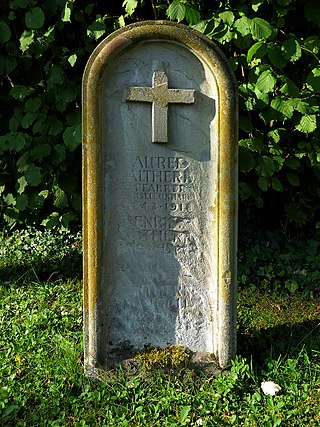
Alfred Altherr was a Swiss Protestant clergyman and writer from the canton of Appenzell Ausserrhoden.